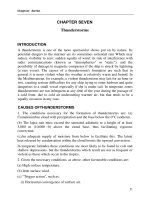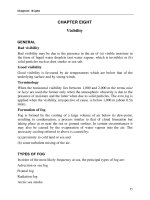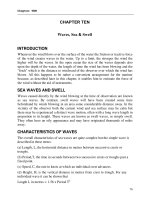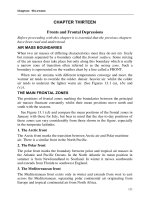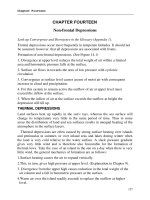BÀI GIẢNG KHÍ TƯỢNG LÝ THUYẾT CHƯƠNG 8
Bạn đang xem bản rút gọn của tài liệu. Xem và tải ngay bản đầy đủ của tài liệu tại đây (46.78 KB, 5 trang )
Chapter Eight
CHAPTER EIGHT
Visibility
GENERAL
Bad visibility
Bad visibility may be due to the presence in the air of (a) visible moisture in
the form of liquid water droplets (not water vapour, which is invisible) or (b)
solid particles such as dust smoke or sea salt.
Good visibility
Good visibility is favoured by air temperatures which are below that of the
underlying surface and by strong winds.
Terminology
When the horizontal visibility lies between 1,000 and 2,000 m the terms mist
or haze are used-the former only when the atmospheric obscurity is due to the
presence of moisture and the latter when due to solid particles. The term fog is
applied when the visibility, irrespective of cause. is below 1,000 m (about 0.5n
mile).
Formation of fog
Fog is formed by the cooling of a large volume of air below its dew-point,
resulting in condensation, a process similar to that of cloud formation but
taking place at or near the sea or ground surface. In certain circumstances it
may also be caused by the evaporation of water vapour into the air. The
necessary cooling referred to above is caused by:
(a) proximity to cold land or sea and
(b) some turbulent mixing of the air.
TYPES OF FOG
In order of the most likely frequency at sea, the principal types of fog are:
Advection or sea fog
Frontal fog
Radiation fog
Arctic sea smoke
55
Chapter Eight
ADVECTION FOG
This is the most widespread type likely to be encountered at sea and is caused
by relatively warm air being cooled by flowing over a cooler sea surface. The
latter will be below the dew-point of the air and normally the wind speed will
be between 4 and 16 knots (between force 2 and 4 on the Beaufort Scale).
There are only certain localities where such conditions are relatively
prevalent. One is off the Grand Banks of Newfoundland where the cold
Labrador current causes a decrease in sea temperature. The warm. moist.
southerly air stream flowing over this is cooled below its dew-point to form
advection. or sea fog.
The English Channel is often affected by advection fog when southwesterly
winds reach the British Isles from the Azores in spring and early summer.
In ocean regions. well away from shallow's and coastal waters. the sea
surface temperature changes very little through solar heating or night
radiation. Generally the daily change in sea surface temperature is less than
5°C.
It is possible to estimate the likelihood of the formation of fog from
observations of air temperatures, wind direction and other weather signs, plus
a knowledge of sea temperatures to be expected on the course ahead.
Admiralty Ocean Routeing Charts give information. for each month of the
year on:
Mean sea temperatures
Mean dew-point temperatures
Percentage frequency of fog (visibility -less than half a mile)
Percentage frequency of low visibility (less than 5 miles) )
Mean air temperatures
Mean barometric pressures
FRONTAL OR MIXING FOG
This may occur along the boundary when two widely differing air masses
meet. Usually associated with either a warm front or a warm occlusion when
cold air meets warm moist air: hence it is normally experienced in temperate
or high latitudes. It is caused by the evaporation of relatively warm rain or
drizzle which in turn cools the air through which it falls.
56
Chapter Eight
RADIATION FOG
This forms over land. most frequently during autumn and winter over lowlying land especially if it is damp and marshy and in valleys on quiet nights
with clear skies. Under these conditions the land loses heat by radiation and
cools the air close to the ground, possibly to below its dew-point. If there is a
gentle breeze blowing, (up to 5 knots) this will cause turbulent mixing but
only close to the surface and condensation in the form of fog will take place.
A stronger wind will cause the cooling to be diffused through a greater depth
of air and the dew-point will not be reached.
Since cold air is heavier than warm air, it will tend to drain down into
valleys. Although it never actually forms over the sea. it may drift from the
land for several miles but seldom extends for more than 10 miles off-shore.
Cloudy skies over-night will reduce the effect of the radiation from the land,
or eyen re-radiate heat back to the surface and radiation fog will not occur
under these conditions.
Radiation fog will be most dense around sunrise and normally disperses
fairly rapidly as the land warms.
ARCTIC SEA SMOKE
This is a type of fog occurring close to the sea surface when the air is dry and
cold - probably at least 9°C below the sea surface temperature. Rapid
evaporation takes place from the relatively warm sea surface into the colder air
and condensation takes place, giving the effect of steam or smoke rising from
the sea.
It is most common in Arctic and Antarctic waters and in the Baltic but it can
also occur off the eastern coasts of continents in winter e.g. off Newfoundland
and over inland seas and lakes. This is one type of fog which may also be
57
Chapter Eight
associated with strong winds since it requires a continual supply of cold air.
MIST, DUST AND HAZE
As stated on page 53, visibility which is impaired but is more than 1,000
metres is described as mist - when caused by water droplets and when the
relative humidity is more than 95%. When caused by smoke or dust particles it
is described as haze.
Causes of the latter range from forest fires, smoke from industrial areas, to
dust or sand storms which may be experienced to seaward -of desert regions
such as off the West African coast or off the Arabian coast when seasonal winds
blow off the land.
Sand storms may extend up to 100 miles out to sea and constitute a serious
problem for the mariner.
SOUND SIGNALS IN FOG
The very conditions which create fog may also cause distortions in-both the
direction from which another ship's fog signal appears to come and in its strength.
The watchkeeper must therefore exercise considerable caution when attempting to
estimate either the distance from another sound source or its direction.
USE OF RADAR IN FOG
Meteorological factors may affect the normal expected range of radars. If humidity
decreases with height, super-refraction may be expected, resulting in a considerable
increase in radar range. On the other hand, if humidity increases with height, subrefraction may be expected with a consequent decrease in range.
Radar range is likely to be more adversely affected by heavy rain than by fog. It
is recommended that further reference is made to the appropriate chapter of a
specialist text-book dealing with radar.
58
Chapter Eight
QUESTIONS:
1. Differentiate between fog, mist and haze.
2 What are the necessary conditions for the formation of fog?
3. Good visibility is favoured by a large lapse rate and strong winds. Why is this
so?
4. Describe the conditions which are most favourable for the formation of radiation
fog.
5. (a) In which seasons does radiation fog most frequently occur? Explain why. (b)
How may radiation fog affect the mariner?
6. At what time of day is radiation fog likely to be most intense? Explain why.
7. Describe the nature and topography of the surface which is most favourable for
the formation and persistence of radiation fog.
8. Discuss the effects of smoke on visibility.
9. Define the term "advection”.
10.What are the conditions necessary for the formation of advection fog?
11.What is the cause of Arctic Sea Smoke?
59

